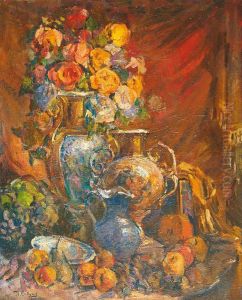Nicolai Nicolaievitch Sapounov Paintings
Nicolai Nicolaievitch Sapounov was a Russian painter and set designer, associated with the Mir Iskusstva (World of Art) movement. Born on June 8, 1880, in Moscow, Russia, Sapounov was part of an artistic milieu that sought to break with the academic traditions of the past and embraced a more individualistic and stylized approach to art.
Sapounov studied at the Moscow School of Painting, Sculpture and Architecture, where he was influenced by Russian folk art and the nascent Symbolist movement. He was particularly close to fellow artists like Sergei Diaghilev, Léon Bakst, and Konstantin Somov, who were central figures in the Mir Iskusstva movement, which promoted an art that was national in spirit but also receptive to the latest trends in European art.
As a painter, Sapounov's work was characterized by a decorative quality and a use of vibrant color. He often depicted fairy-tale scenes, mythological subjects, and Russian historical themes, infusing them with a dream-like atmosphere that was in tune with the Symbolist ethos of the time. His paintings were exhibited widely in Russia and abroad, and he was recognized as a significant talent within the Russian avant-garde.
In addition to his work as a painter, Sapounov was also involved in theater and opera as a set designer. He collaborated with Diaghilev on productions for the famous Ballets Russes, where he worked alongside other prominent artists of the era. His set designs were known for their imaginative qualities and their ability to enhance the theatrical experience through their visual impact.
Tragically, Nicolai Sapounov's life and career were cut short when he died on July 6, 1912, at the age of 32. Although his career was brief, his contributions to Russian art were significant, and he is remembered today for his role in the flourishing of Russian culture during the Silver Age. His works can be found in various museums and collections, where they continue to be appreciated for their lyrical beauty and innovative spirit.
